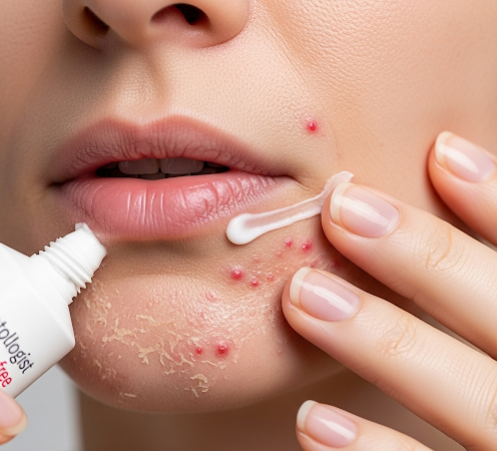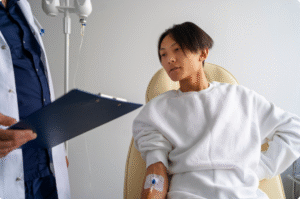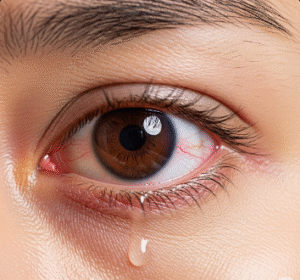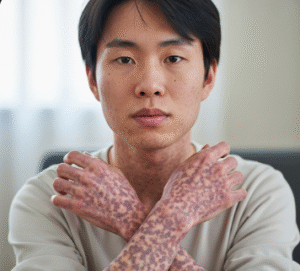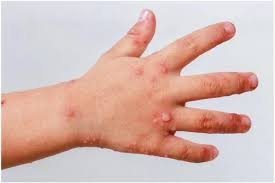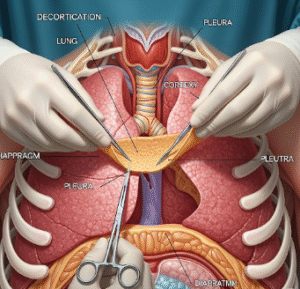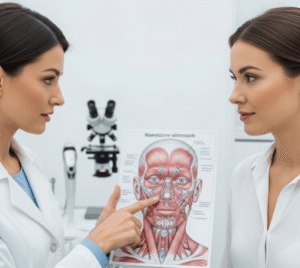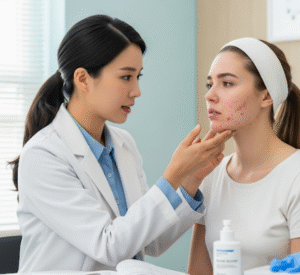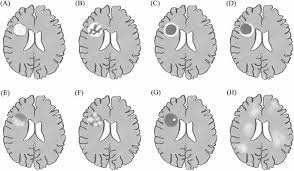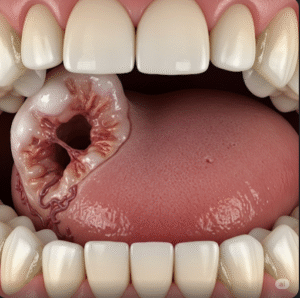What it is
Perioral Dermatitis (POD) is a chronic skin condition that causes clusters of red bumps, papules, or pustules around the mouth, nose, and sometimes the eyes (periocular dermatitis). It often looks like acne or rosacea but is distinct in its pattern and cause. The skin may feel burning, itchy, or irritated, and sometimes a clear fluid discharge appears.
Triggers include:
- Overuse of topical corticosteroids
- Harsh skincare products or heavy cosmetics
- Fluoridated toothpaste
- Hormonal changes
- Stress and environmental factors
In Korea, perioral dermatitis is managed with a combination of dermatological treatment, gentle skincare routines, and lifestyle modifications, reflecting the Korean medical philosophy of skin barrier restoration plus cosmetic balance.
Why it’s done
Care for perioral dermatitis is important to:
- Relieve symptoms → Redness, burning, and irritation can interfere with comfort.
- Prevent chronicity → Untreated POD may persist for months or even years.
- Avoid misuse of steroids → Topical corticosteroids worsen the condition if continued.
- Improve cosmetic appearance → The condition is often visible and affects self-confidence.
- Restore skin barrier → Essential for long-term recovery and prevention of relapse.
In Korea, treatment is also done for aesthetic recovery, since skin clarity and balance are highly valued in beauty culture.
Alternatives
Treatment approaches may vary depending on severity. Alternatives include:
- Topical therapies
- Metronidazole cream or gel
- Azelaic acid
- Topical antibiotics (clindamycin, erythromycin)
- Calcineurin inhibitors (pimecrolimus, tacrolimus)
- Oral therapies
- Tetracyclines (doxycycline, minocycline)
- Macrolides (erythromycin, clarithromycin) for those intolerant to tetracyclines
- Supportive skincare
- “Zero therapy” → Stopping all steroids, irritants, and heavy cosmetics
- Switching to mild, pH-balanced cleansers and fragrance-free moisturizers
- Lifestyle-based alternatives
- Stress management (yoga, meditation, sleep regulation)
- Switching to non-fluoridated toothpaste in some cases
- Reducing alcohol, spicy foods, and caffeine
In Korea, dermatologists often favor gentle regimens plus medical treatment, and integrate barrier-restoring K-beauty products into the recovery plan.
Preparation
Before beginning treatment:
- Stop topical steroids → This is the most important step, even though withdrawal may temporarily worsen symptoms.
- Dermatology consultation → To rule out acne, rosacea, or allergic contact dermatitis.
- Skin analysis → Korean clinics often use AI-based skin scanning tools.
- Product history review → Identify potential irritants in cosmetics or skincare.
- Patient education → Preparing for a possible “flare-up phase” before improvement begins.
How it’s Done
The management of perioral dermatitis in Korea often involves a multi-step process:
- Zero therapy (detox phase)
- Eliminate steroids, heavy creams, and irritating skincare.
- Switch to gentle Korean cleansers and basic barrier moisturizers.
- Medical treatment
- Topical antibiotics or anti-inflammatory creams prescribed for mild cases.
- Oral tetracyclines given for moderate to severe POD (6–12 weeks).
- Barrier repair
- Use of moisturizers with ceramides, panthenol, and madecassoside.
- Avoidance of alcohol-based or fragranced skincare.
- Adjunctive therapy
- LED light therapy (blue or red light) for inflammation reduction.
- Probiotic-based skincare serums to restore microbial balance.
- Herbal calming packs with centella asiatica or green tea extracts.
Recovery
Perioral dermatitis usually requires patience and careful management:
- Initial phase → Symptoms may temporarily worsen after steroid withdrawal.
- Improvement phase → Redness and bumps typically reduce within 3–6 weeks.
- Full recovery → Most patients achieve remission within 8–12 weeks.
- Maintenance → Gentle skincare and avoidance of known triggers to prevent recurrence.
In Korea, follow-up care includes regular skin imaging, hydration therapies, and maintenance with mild K-beauty serums.
Complications
Possible issues if untreated or poorly managed include:
- Chronic relapsing POD with repeated flare-ups
- Post-inflammatory hyperpigmentation (PIH), especially in Asian skin
- Steroid dependency from continued misuse of corticosteroid creams
- Psychological effects like self-consciousness and anxiety
Korean dermatologists proactively prevent complications by starting early treatment and using pigmentation-correcting skincare if PIH develops.
Treatment Options in Korea
Korea is well-known for combining medical precision with advanced cosmetic care, and perioral dermatitis management reflects this:
- Minimalist skincare detox programs → Dermatologists guide patients to stop irritants and simplify routines.
- Medical-K-beauty integration → Prescription therapies paired with gentle, hydrating Korean skincare.
- Customized topical formulations → Compounded creams containing antibiotics + soothing agents.
- Adjunctive technology → LED therapy, microbiome testing, and AI-based monitoring.
- Holistic care → Diet advice, stress reduction programs, and lifestyle coaching.
- Long-term maintenance → Monthly dermatology check-ups and skincare refinement to avoid relapses.
✅ Key Point: Perioral Dermatitis care in Korea emphasizes removing triggers, restoring skin balance, and combining medical treatments with K-beauty barrier repair methods, ensuring patients recover both medically and aesthetically with minimal relapse risk.

